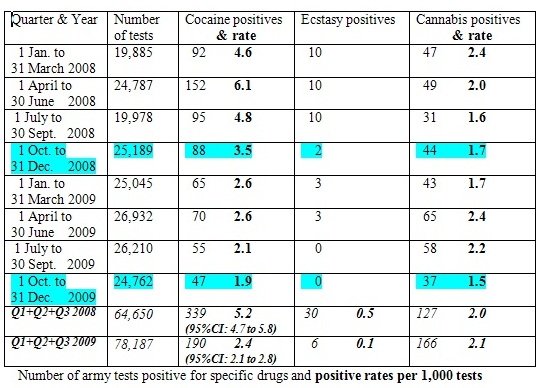Mephedrone's take-off tracked with military precision
The Independent’s Michael Savage put in a Freedom of Information request on the results of compulsory drugs testing (CDT) in the British Army during 2000 to 2009.
Clear evidence emerged that both the cocaine positive rate per 1,000 tests and the ecstasy positive rate had plummeted. In the case of cocaine: from 4.8 positives per 1,000 tests in 2008 (based on around 90,000 tests) to 2.3 in 2009.
But when did these changes in soldiers’ off-duty use of cocaine and ecstasy first become evident in the army’s CDT programme?
Patrick Mercer MP asked for the CDT results to be made available by quarter-year in 2008 and 2009. A sharp change could have come about if soldiers had switched from weekend use of cocaine/ecstasy to use of the ‘legal high’ mephedrone, for which the army does not test. Was there evidence of a sharp change?
Based on the prompt answer to Patrick Mercer’s parliamentary question, the Table below shows that soldiers’ cannabis rate remained broadly stable at 2 cannabis positives per 1,000 tests throughout 2008 and 2009. But their cocaine/ecstasy rates nose-dived from the last quarter of 2008.
Soldiers’ cocaine positive rate had averaged 5.2 per 1,000 tests in the first three quarters of 2008. It reduced to 3.5 per 1,000 tests in the last quarter of 2008, and thereafter further reduced to 2.4 or 1.9 cocaine positives per 1,000 tests by the last quarter of 2009.

The new data do not ‘prove’ that mephedrone was responsible for the sudden change, but they date the change pretty effectively.
If mephedrone is responsible and if soldiers’ switching is any guide to the civilian prevalence of mephedrone, then civilian use of mephedrone may also have risen very quickly and dramatically to at least half the prevalence of cocaine use.
Retrospective testing of soldiers’ urine samples for mephedrone is not feasible as negatively-screened urine samples are not retained. However, retrospective testing for the presence of mephedrone in stored blood samples from drugs-related deaths in the winter semester of 2007/08; 2008/09; and 2009/10 could be highly informative.
Forensic toxicologists are working on validation of the necessary tests. The new CDT results help us to pinpoint when the change may have occurred, and so how to design the retrospective testing cost-efficiently.



